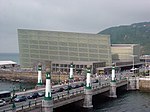Urumea
Gipuzkoa

The Urumea (Basque: [uˈɾumea] or [uɾuˈmea], stemming from Basque "ur" 'water' + "me(he)a" 'thin') is a river in the Basque Country at the north of the Iberian Peninsula. It's one of a series of Basque rivers flowing into the Bay of Biscay (Atlantic basin) and is best known for being the river flowing towards the sea by the city of San Sebastian.
Excerpt from the Wikipedia article Urumea (License: CC BY-SA 3.0, Authors, Images).Urumea
Etxague Jenerala kalea, San Sebastián Parte Zaharra - Parte Vieja (Erdialdea)
Geographical coordinates (GPS) Address Nearby Places Show on map
Geographical coordinates (GPS)
| Latitude | Longitude |
|---|---|
| N 43.326111111111 ° | E -1.9822222222222 ° |
Address
Etxague Jenerala kalea
20003 San Sebastián, Parte Zaharra - Parte Vieja (Erdialdea)
Autonomous Community of the Basque Country, Spain
Open on Google Maps










